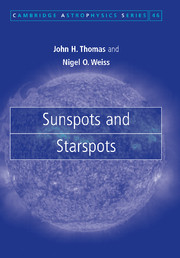Book contents
- Frontmatter
- Contents
- Preface
- 1 The Sun among the stars
- 2 Sunspots and starspots: a historical introduction
- 3 Overall structure of a sunspot
- 4 Fine structure of the umbra
- 5 Fine structure of the penumbra
- 6 Oscillations in sunspots
- 7 Sunspots and active regions
- 8 Magnetic activity in stars
- 9 Starspots
- 10 Solar and stellar activity cycles
- 11 Solar and stellar dynamos
- 12 Solar activity, space weather and climate change
- 13 The way ahead
- Appendix 1 Observing techniques for sunspots
- Appendix 2 Essentials of magnetohydrodynamic theory
- References
- Index
12 - Solar activity, space weather and climate change
Published online by Cambridge University Press: 28 October 2009
- Frontmatter
- Contents
- Preface
- 1 The Sun among the stars
- 2 Sunspots and starspots: a historical introduction
- 3 Overall structure of a sunspot
- 4 Fine structure of the umbra
- 5 Fine structure of the penumbra
- 6 Oscillations in sunspots
- 7 Sunspots and active regions
- 8 Magnetic activity in stars
- 9 Starspots
- 10 Solar and stellar activity cycles
- 11 Solar and stellar dynamos
- 12 Solar activity, space weather and climate change
- 13 The way ahead
- Appendix 1 Observing techniques for sunspots
- Appendix 2 Essentials of magnetohydrodynamic theory
- References
- Index
Summary
Viewed as a star, the Sun exhibits very mild variability. Its total luminosity fluctuates by only 0.1%, following the sunspot cycle. Although most of the energy radiated is in the visible and infrared ranges, corresponding to the peak in the Planck spectrum for the photosphere, the temperature rises through the chromosphere, and then undergoes an abrupt transition to reach millions of degrees in the corona. Since the structure of the solar atmosphere is dominated by its magnetic field, it is not surprising that the Sun's ultraviolet, extreme ultraviolet and X-ray emission vary much more drastically as a result of solar activity. This activity also gives rise to flares and coronal mass ejections, generating energetic particles and enhanced magnetic fields that are carried outwards into interplanetary space by the solar wind. These then impinge upon the Earth, producing aurorae and magnetic storms.
In this chapter we describe the solar irradiance variations and the influence of solar activity on the heliosphere, which gives rise to ‘space weather’. We also explain how the incidence of geomagnetic storms, which have been studied since the time of Gauss, provides a proxy measure of the Sun's open magnetic flux, which is responsible for deflecting galactic cosmic rays. Finally, we consider the controversial topic of the influence of solar variability on terrestrial climate (Friis-Christensen et al. 2000; Haigh 2003, 2007); here we emphasize that this influence, though it is clearly present, remains small compared with the recent global warming caused by anthropogenic greenhouse gases.
- Type
- Chapter
- Information
- Sunspots and Starspots , pp. 211 - 228Publisher: Cambridge University PressPrint publication year: 2008



